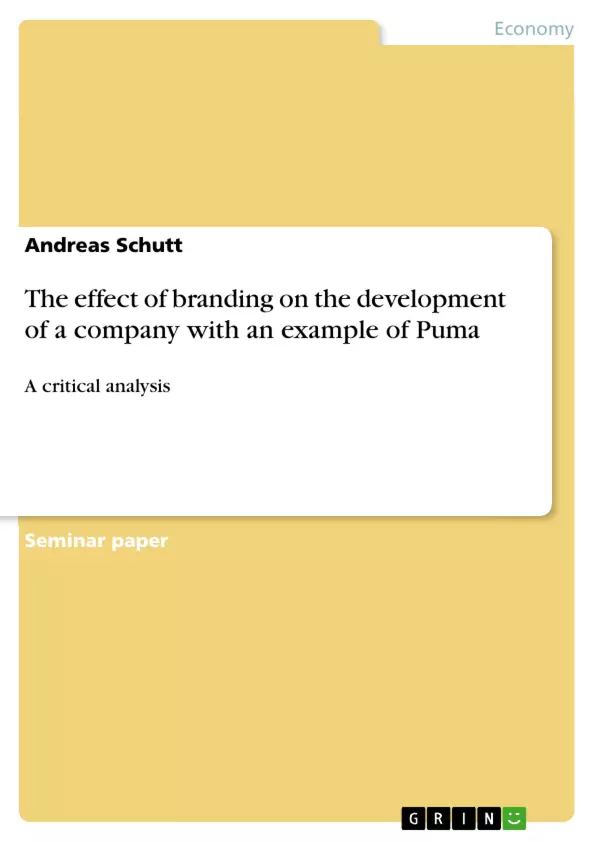On the one hand, brands can increase a company’s value significantly or even represent the company itself. On the other hand, consumers want to take over the image of a brand and identify themselves with the characteristics carried by the brand. This goes along with the need of having branded goods as a mark of status and belonging.
Therefore, companies need to focus on strengthening their brand image and brand equity in order to succeed on the market and diversify themselves from their competitors.
However, the question is, are the efforts in creating a strong brand image and high brand equity justified when thinking about the impact on the consumer?
Why are so many companies focusing on image instead of paying attention to the quality of their products? And why do so many companies spent money on sponsoring sports teams instead of investing in the improvement of their product’s characteristics or developing new innovative products?
In order to get into the topic, this case study will have a look at Puma as a concrete example of how branding affects a company.
The intention of this case study is to point out how Puma achieved the way from a shoe manufacturer to a well-known lifestyle brand by looking at the creation of a brand image on the one hand and an increase in brand equity on the other hand.
- Does a positive brand image have an influence on a company’s turnover?
- Does a high brand equity influence a company’s economic development or does a positive development of a company increase its brand equity?
- Do brands have an effect on consumer’s buying behaviour?
Inhaltsverzeichnis (Table of Contents)
- Introduction
- Problem
- Aim of this work
- Structure of this work
- Branding
- History of Branding
- Brand Definition
- Self-Image and Brand Image
- Brand Name and Logo
- Brand Strategy
- Individual Brands
- Extension and Stretching
- Family Branding
- Brand Entertainment
- Product Placement
- Ingredient Branding
- Brand Equity
- Monetary Valuation
- Behavioural Valuation-Models
- Combination of Monetary and Behavioural Models
- Consumer Choice
- Basics of Buying Behaviour
- Categories of Buyers
- Roles of Buyer
- Basic Buying Process
- Consumer's Fashion Adoption Process Model
- The Consumer
- Involvement
- External Influence Factors
- Internal Influence Factors
- Cultural factors
- Social factors
- Personal factors
- Psychological factors
- Motivation
- Perception
- Attitude
- Learning
- Puma
- History of Puma
- History of Puma as a Brand
- Brand Strategy
- Puma's Four-Phase-Strategy-Plan
- Brand Extension and Stretching
- Brand Entertainment
- Product Placement
- Brand Image
- Effect on Puma's economical Development – brand equity
- Annual Report
- Puma's Brand Equity
- Summary and Conclusion
- Critical View on Branding and Brand Equity Evaluation
- Critical View on Puma as a Brand
- View into the Future
- Sources
- Internet-Sources
- Literature-Sources
Zielsetzung und Themenschwerpunkte (Objectives and Key Themes)
This case study aims to analyze the effect of branding on the development of a company, using Puma as an example. It examines the history and strategy of branding, including brand equity, and explores how these elements impact consumer behavior. The study also delves into Puma's history as a brand, its brand strategy, and how its branding has influenced its economic development.
- The importance of branding in modern business
- The role of brand image and brand equity in company success
- The influence of branding on consumer choice and buying behavior
- Puma's branding strategy and its impact on the company's development
- The evaluation of brand equity and its significance in measuring brand performance
Zusammenfassung der Kapitel (Chapter Summaries)
- Introduction: This chapter introduces the concept of branding and its increasing importance in the business world. It highlights the growing significance of brands for both companies and consumers. The chapter then sets the stage for the case study by outlining the problem of evaluating the impact of branding on consumer behavior and the choice of Puma as an example.
- Branding: This chapter delves into the history and definition of branding, exploring concepts such as self-image, brand image, brand name, and logo. It then examines various brand strategies, including individual brands, brand extension, family branding, brand entertainment, product placement, and ingredient branding. The chapter concludes with a discussion on brand equity, encompassing its monetary valuation, behavioral valuation models, and the combination of both.
- Consumer Choice: This chapter explores the basics of buying behavior, examining categories and roles of buyers, the basic buying process, and the Consumer's Fashion Adoption Process Model. It then focuses on the consumer, examining factors influencing their behavior, including involvement, external influence factors, and internal influence factors such as cultural, social, personal, and psychological factors. The chapter delves deeper into the psychological factors, analyzing motivation, perception, attitude, and learning.
- Puma: This chapter provides a historical overview of Puma, both as a company and as a brand. It then examines Puma's brand strategy, particularly its Four-Phase-Strategy-Plan, brand extension and stretching, brand entertainment, and product placement. The chapter further discusses Puma's brand image and its effect on the company's economic development, analyzing its annual report and brand equity.
Schlüsselwörter (Keywords)
This case study focuses on key concepts such as branding, brand image, brand equity, consumer behavior, buying behavior, brand strategy, brand extension, product placement, and brand entertainment. It uses Puma as a concrete example to analyze the impact of these elements on a company's development.
- Arbeit zitieren
- Dipl. Wirt.-Inf. (FH), Dipl. Kfm. (FH), BBA Andreas Schutt (Autor:in), 2009, The effect of branding on the development of a company with an example of Puma, München, GRIN Verlag, https://www.grin.com/document/177238



